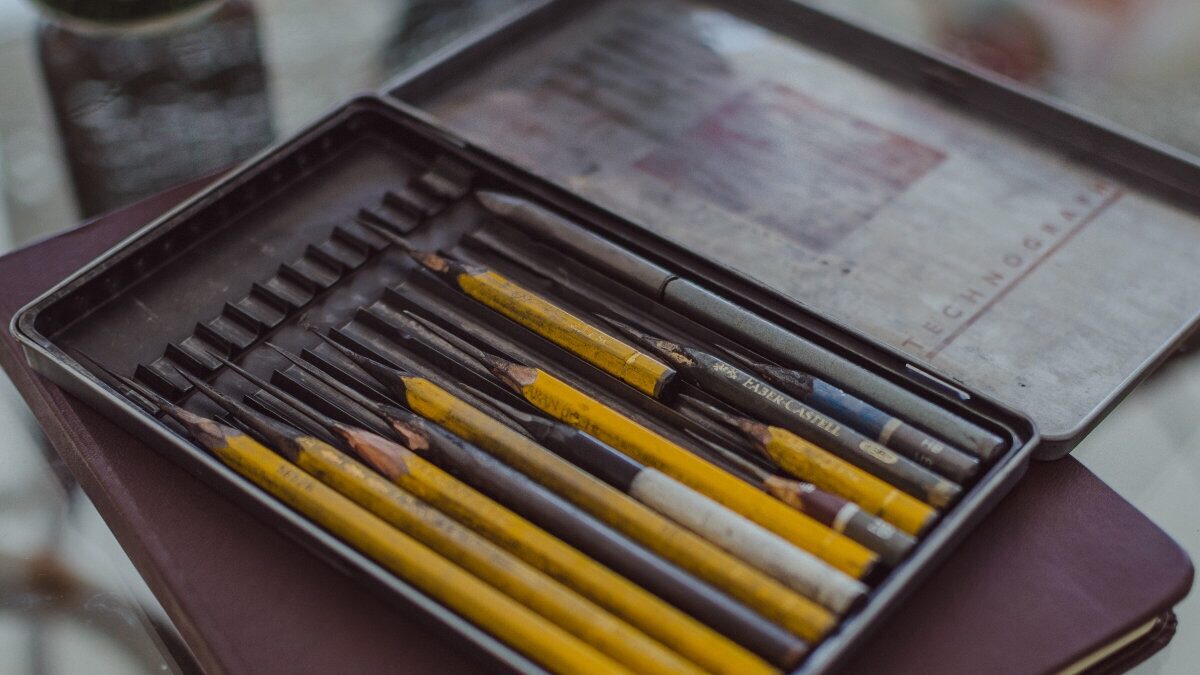If you are going to be doing any pencil drawing you are going to need a pencil first of all. Seems very obvious…. However, in this article, I will be discussing some of the various options available. Options such as traditional wooden pencils, Lead Holders, Mechanical Pencils, and Woodless Graphite.
Wooden Pencils
Okay. We all know what a wooden pencil is, but for the sake of this article let’s elaborate a bit. It is a yellow pencil with a pink eraser on top and a number 2 marked on it. You know, the ones we used in school to fill in the little circles on our multiple-choice tests.
Lead Holders
These are like mechanical pencils in that you can use a variety of leads with them. But instead of pushing a button to release more lead, these pencils have kind of a claw that grabs on and holds the lead. Hence the term “lead holder.”
Mechanical Pencils
You are more than likely familiar with these. They are the ones that hold the lead (graphite actually) inside and when you push on the eraser more lead comes out. What you may not know is that, like traditional wooden pencils, the leads are available in varying degrees of hardness that can be used to achieve lighter or darker tones as needed. We will talk more about that later.
Woodless Graphite
These pencils are a piece of graphite in the shape of a pencil. Some woodless graphite pencils are covered in a lacquer coating instead of wood.
Yes, those are pencils, but a set of decent-quality drawing pencils comes with much more variety than that. All the pencil types mentioned above come in varying degrees of hardness and are labeled with a number and the letter H or B. The pencils labeled H are on the hard side and leave less graphite on the paper (lighter). The ones labeled with a B are the soft ones and leave more graphite behind (darker).
Pencils range from 9H (the hardest) to 9B (the softest).
The number 2 pencils we are so familiar with fall in the middle in terms of hardness. They are comparable to an HB pencil. If you are just starting out drawing, doing some sketching, or doodling, an #2 or HB will work fine for you. You can achieve darker tones with number 2 pencils simply by pressing down harder. However, if you want to achieve a much more interesting drawing you will require some contrast between lights and darks. That is where the softer pencils come in.
Softer Pencils
After #2 in relation to softness comes B then 2B, 3B, etc. all the way up to 9B. Even so, many artists rarely use anything softer than a 6B. With a 6B, you can get some very dark tones and it is not going to be as soft and thus crumbly as a 9B.
Harder Pencils
For the harder pencils, I seldom use anything harder than a 2H and that is usually just for the original line drawing before any shade takes place. Doing the initial line drawing very lightly allows you room to erase any mistakes you might have made. Once your line drawing is accurate, it is time to get the softer pencils out and start shading.
Conclusion: So, to wrap this up, if you are planning to get a little more serious with your drawing, you will want to get a set of pencils. There are some sets out there that have just 4 pencils in them. So, if you are on a budget this is an option. Pencils are also available individually so you can choose whichever number/letter combo you need.
I prefer traditional wooden pencils for my drawings, and my brand of choice is Derwent. They make sets of 12 pencils that range from 4H to 6B or from H all the way up to 9B. Alternatively, you can get a set of 12 pencils for about $12 – $15 so it is not terribly expensive to get into drawing. So, for now, go purchase yourself a good set pencil and start drawing….

